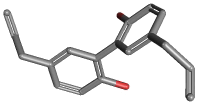|
MAGNOLOL |
| Synonyms. Magnolol; 5,5'-Di-2-propenyl-(1,1'-biphenyl)-2,2'-diol; 5,5'-Diallyl-2,2'-dihydroxybiphenyl; 5,5'-Diallyl-2,2'-biphenyldiol; 2,2'-Bichavicol; 5,5'-Diallyl-(1,1'-biphenyl)-2,2'-diol; 5,5'-di(prop-2-en-1-yl)biphenyl-2,2'-diol; 2-(2-Hydroxy-5-prop-2-enylphenyl)-4-prop-2-enylphenol; |
|
|
| PRODUCT IDENTIFICATION | |
|
CAS RN |
528-43-8 |
|
EINECS RN |
|
|
FORMULA |
C18H18O2 |
|
MOLE WEIGHT |
266.33 |
|
H.S CODE |
2907.29.9000 |
|
SMILES |
c1(c2c(ccc(c2)CC=C)O)c(ccc(c1)CC=C)O |
|
CLASSIFICATION |
Phytochemical, Analgesic, Anti-Inflammatory, Hematologic |
|
EXTRA NOTES |
Biochem/physiol Actions:Bioactive plant component with antifungal, antibacterial and antioxidant effects. Magnolol also demonstrates anti-inflammatory activity by interferring with NF-κB signaling. (sigmaaldrich) |
|
|
| PHYSICAL AND CHEMICAL PROPERTIES | |
|
PHYSICAL STATE. |
white to off-white crystalline powder |
|
MELTING POINT |
101 ~ 102 C |
|
BOILING POINT |
|
|
DENSITY |
|
|
SOLUBILITY IN WATER |
|
| SOLVENT SOLUBILITY |
|
|
VAPOR DENSITY |
|
|
log P(octanol-water) |
|
|
VAPOR PRESSURE |
|
|
AUTOIGNITION TEMP |
|
| pK |
|
|
REFRACTIVE INDEX |
|
|
FLASH POINT |
|
|
|
| STABILITY AND REACTIVITY | |
| STABILITY | Stable under normal conditions. |
|
INCOMPATIBLE MATERIALS |
Strong oxidizing agents |
| POLYMERIZATION |
Has not been reported |
|
NFPA RATINGS |
Health: 2, Flammability: 0, Reactivity: 0 |
|
|
| EXTERNAL LINKS & GENERAL DESCRIPTION |
|
USA.gov - Magnolol Wikipedia Linking - Magnolol Google Scholar Search - Magnolol U.S. National Library of Medicine - Magnolol PubChem Compound Summary - Magnolol Drug Bank - Magnolol KEGG (Kyoto Encyclopedia of Genes and Genomes) - Magnolol http://www.ebi.ac.uk/chebi/ - Magnolol http://www.ncbi.nlm.nih.gov/ - Magnolol Hazardous Substances Data Bank - Magnolol EPA - Substance Registry Services - Magnolol |
|
|
| SALES SPECIFICATION | |
|
APPEARANCE |
white to white powder |
|
ASSAY |
98% min |
|
MELTING POINT |
101 ~ 102 C |
|
LOSS ON DRYING |
1% max |
|
HEAVY METALS |
10ppm max |
|
|
| TRANSPORT & REGULATORY INFORMATION | |
|
UN NO. |
3077 |
| HAZARD CLASS |
9 |
| PACKING GROUP | III |
|
|
| SAFETY INFORMATION | |
|
HAZARD OVERVIEW |
GHS (Globally Harmonised System) Classification: Skin irritation, Serious eye damage, Specific target organ toxicity - single exposure, Acute aquatic toxicity, Chronic aquatic toxicity. Hazard statements: Causes skin irritation. Causes serious eye damage. May cause respiratory irritation. Toxic to aquatic life with long lasting effects. |
| SIGNAL WORD | Warning |
|
PICTOGRAMS |
|
|
HAZARD STATEMENTS |
H315-H318-H335-H411 |
|
P STATEMENTS |
P261-P273-P280-P305 + P351 + P338 |
| EC DIRECTIVES |
|
| HAZARD CODES |
|
|
RISK PHRASES |
37/38-41-51/53 |
|
SAFETY PHRASES |
26-39-61 |
|
|
| PACKING |
|
Preserved in light-resistant and well-closed bottles |
|
|



